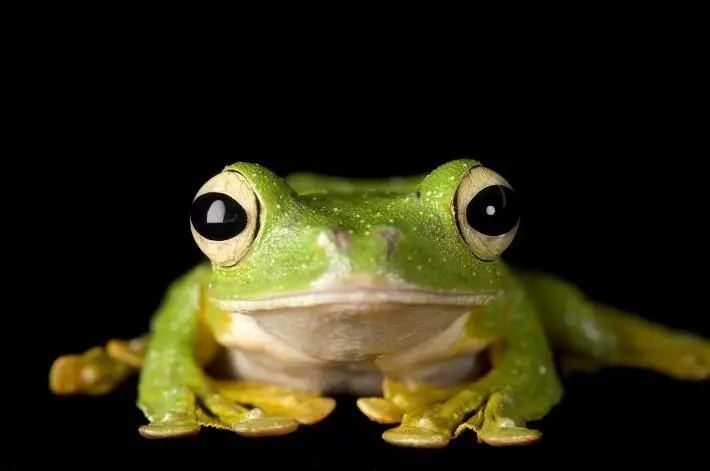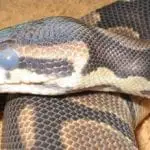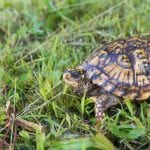Wallace’s Flying Frog is the common name for the flying frog, and its scientific name is Rhacophorus Nigropalmatus. Flying frogs are sometimes called moss frogs, bush frogs, Old World Tree frogs, shrub frogs, afro-Asian tree frogs, or Rhacophoridae. The flying frogs can be seen across China, sub-Saharan Africa, much of tropical Asia, Sulawesi, Japan, and the Philippines.
As of 2015, 380 species of flying frogs were recognized. Most of the rhacophoridae or the flying frogs are sometimes semi-arboreal and sometimes arboreal, and they used to live in shrubs, bushes, and trees, the places that are close to the ground level to the way up to the forest canopy. As a result of increased deforestation, there is the destruction of the habitat of the flying frogs, and negative pet trading causes the populations of the flying frogs to decrease in the wild.
Flying Frogs in the Wild
Flying frogs spend their time on the trees where they can glide in the air due to its extremely webbed feet and skin that were told alongside the body. When the flying frogs were threatened, or they were in search of prey, the flying frog will leap from a branch, and they splay their four webbed feet to escape.
It is their escape mechanism to all the predators that they might meet in the wild and for them to be safe. It is somewhat a very useful ability that they have to survive wherever they are. They are meat-eater, so they mostly eat insects around them just like bugs.
Gliding Flight
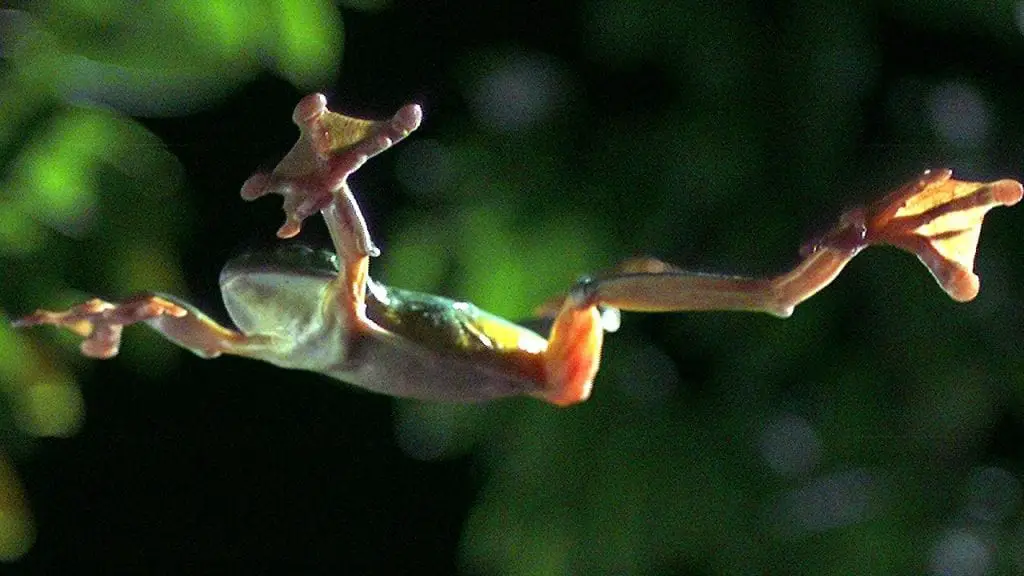
The gliding flight of the flying frog is descending into 45 degrees relative to horizontal, and descending in a larger angle is known as parachuting. The flying frog’s ability to glide is for them to search for their food, to escape from predators, and to descend in the forest floor to mate and lay eggs.
They tend to use their powerful hind legs to launch their lightweight body from a high branch Into the air. Flying frogs spread outs they’re large webbed feet and hands. The membranes of the skin that the flying frog has acted as a miniature parachute that slows them down whenever the descend. By moving the legs of the flying frogs or even twisting their toes, they were able to turn as they glide. That’s why they can land; it’s either to the left or right direction of their original direction of launch.
Things to Know About Flying Frogs
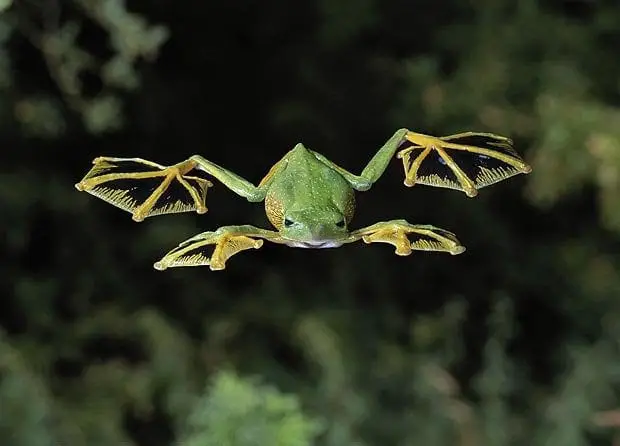
- Female flying frogs are much bigger than the male flying frogs. These flying frogs can also reach 4 inches in length.
- The lateral sides of the body of the flying frogs such as their toes, thighs, and their snout are covered with yellow patches while overall, the flying frog is brightly colored green. The flying frog’s throat and belly are somewhat white or pale yellow colored. The skin of the flying frogs is slightly granulated or smooth.
- 3. The flying frogs have extremely large feet with fully webbed toes and fingers. The toe pads of the flying frogs are oversized and are disc-shaped. On the sides of the body of the flying frogs, there is a flap of loose skin that stretches between the limbs.
- The flying frogs have a slender body and long legs. They also have a broad head with a round snout, and also these flying frogs have large eyes and eardrums.
- The biggest mystery ever is the lifespan of flying frogs that are still unknown.
- The usual feet and flap of the skin of the flying frog serve as their parachute that facilitates movement through the air. The soft disc-like pads of the flying frog ensure a gentle landing. The flying frogs also use their large ads just to stick to the surface of the trees.
- The flying frogs generally do not fly, but rather they glide through the air for them to escape from predators such as large snakes in the wild. Flying frogs were able to travel or glide in a distance of 50 feet, and they can safely land on another branch of a tree. At an angle of fewer than 45 degrees flying frogs can glide diagonally, and each gliding session, they get closer to the ground. This type of movement of the flying frogs is known as the “parachuting.”
- Flying frogs move to the ground only to reproduce and, of course, for them to lay their eggs.
- The diet of the flying frogs was based on various insects. Flying frogs are a carnivore or meat-eater.
- Flying frogs are gathered in large groups that were called the armies. These flying frogs mate only during the rainy season.
Mating and Fertilization
The mating of flying frogs was only taken place on the ground during night time. The female flying frog produces a liquid substance and that they stir it with their hind legs until it becomes foamy.
Also, flying frogs have their external fertilization. The female flying frog lays an egg into the foam she made and waits for the male flying frog or her partner to cover it up with its sperm. The foamy nests are now attached to the branches above the shallow pools of water.
When the embryonic development of the flying frog is complete, that foamy nests now fall apart, and the tadpoles fall directly into the water where the tadpoles can finish their metamorphosis and that they can turn into adult frogs.
Above the wallowing holes of the Asian rhinoceros, the female flying frogs usually lay their eggs. Unfortunately, the Asian rhinoceros are on the brink of extinction, which means that the survival of the remaining flying frogs in the wild might also be questioned.
Unique Skin of Flying Frogs
The skin of a flying frog performs a lot of functions. Flying frogs absorb water through their thin skin on their abdomen, which is called “pelvic patch” instead of drinking water. Also, through their skin, they draw in oxygen and release carbon dioxide, where they were able to breathe instead of breathing through their lungs.
By producing mucous glands in their skin, the flying frogs were able to do this. The mucous that the flying frog produces gives the skin a slippery film that protects them against any bacterial, and it also held the flying frog to give its predators ‘’the slip”.
Flying Frogs Behavior and Activities
- Flying frogs are amphibians, and also they are known for their ability to jump. Not only for jumping and hopping, but they are also known for their gliding skills.
- Flying frogs and other frogs have the ability to regulate their body temperature by temperature by changing their skin color. They do this to provide themselves comfort and relaxation.
- Flying frogs also have the ability to jump and hopping on the ground.
- Flying frogs also like the heat of the sun.
- Flying frogs are becoming a pet of human beings.
- This kind of frog is unique because it possesses the ability to glide.
- They used to live in the rainforest in Southeast Asia.
- Wallace’s frog is the first flying frog to be described.
- They are large vivid tree frogs. Also, flying frogs are much lighter in the weight other than the other non-flying frogs.
- This kind of species is hard to handle because their lifespan is still in the study.
Habitat of Flying Frogs
Flying frogs usually occurs in moist tropical forests. Flying frogs primarily found in rainforests that have been untouched, but they may also inhabit forests that have regrown after having been harvested. Flying frogs usually do not occur in places that had the absence of trees and bushes.
Also, flying frogs were living in a place that is warm and moist so that they can live much longer because their lifespan is still unknown. Knowing that they can glide, these flying frogs do not fly. The membranes that are between the toes of the flying frog and the loose skin that they have flaps on their sides, and it catches the air as the flying frog falls, helping them to glide, and they can sometimes glide 50 feet or more. The flying frogs have particularly inhabited the places of Malaysia and Borneo. This flying frogs usually do not live in captivity.
Are Flying Frog Endangered Species?

This kind of species of frog is widely distributed in protected places in this world. That’s why we do not need to worry about its endangerment. The population of these flying frogs is still considered stable. They are just in danger because of forest destruction and the petting of them by human beings. Flying frogs are usually in the wild, but the people are separating them from their natural habitat by turning them into a pet. These flying frogs do not have a specific reason to be endangered, but one thing is for sure what humans do causes the loss of the precious flying frogs in the wild.
Conclusion
Now you’re more knowledgeable about flying frogs. You know how they look like, their behaviors and activities, and how they perform or live in the wild. All of these things will help you become a better pet owner should you want to adopt a flying frog.

